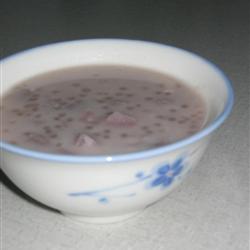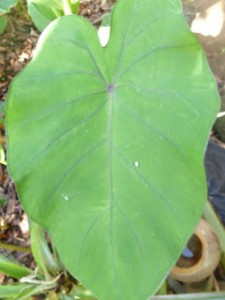My aunt by marriage is Japanese, and although she has been in this country since she was a young bride, she has not conformed to the American way of life in many ways. She still eats Japanese food – with chopsticks, still writes and reads in Japanese, and grows Japanese vegetables in her garden. One of the plants she grows looks like an elephant ear to me, but she eats the roots, and calls it “slimy potatoes”. I have to confess that I have never tried her slimy potatoes, even though I am usually game for eating anything. Maybe it’s all in the name. She gave me some this past summer, though, to grow and sell at the farmer’s market. I did a little research so I’d know what I was selling. Turns out what she grows is actually called taro, or satoimo in Japanese (which translates literally, “village potato”), and while it looks just like an elephant ear with a casual glance, it is important to know that there is a difference. Elephant ears shouldn’t be eaten, whereas taro is safe, and according to Aunt Rose, tasty. The way to tell the difference is in a small distinction in the leaves. I found a very good explanation, complete with helpful pictures, at this site… http://www.mauijungalow.com/2012/03/taro-vs-elephant-ear-telling-them-apart.html
Growing them in the United States is relatively easy, and like elephant ears, they like a lot of water. They even do well (maybe better) in a swampy or flooded area. This is why this type of plant is often seen underneath window unit air conditioners.
 There are way more recipes using taro than I ever imagined, including soups, gnocchi, fritters, meat dishes, chips, ice cream, cake, and other desserts. The best place I have found for these is Yummly, through this link…http://www.yummly.com/recipes/taro . This site is complete with pictures, ingredients, directions, and nutritional facts on each recipe you click on.
There are way more recipes using taro than I ever imagined, including soups, gnocchi, fritters, meat dishes, chips, ice cream, cake, and other desserts. The best place I have found for these is Yummly, through this link…http://www.yummly.com/recipes/taro . This site is complete with pictures, ingredients, directions, and nutritional facts on each recipe you click on.
Taro is a starchy vegetable, and is as versatile as potatoes and rice. The roots (called “corms”), are pale purple and can be roasted, baked or boiled. They have natural sugars, which give them a sweet nutty flavor. The starch in taro is easily digestible, and the grains are fine and small, making it good for baby food. It is best to boil the leaves and stems a couple of times before eating, for better favor. The leaves and stems are a good source of vitamins A and C and have more protein than the roots.
If you are interested in more, Wikipedia has quite a lot of information, including it’s different uses in different parts of India and Asia, where it originated. Check it out here…http://en.wikipedia.org/wiki/Taro
Now that I have done all this reading, I am going to try some of the recipes I found. It would be a cheap and easy to grow food source, that not only comes back year after year, but multiplies.


I’ve also heard it called araimo in Japanese or dasheen, not sure if the latter is Japanese or not. To me, it looks like a taro leaf growing in my garden.
GLAD you posted this I have a plan to plant Elephant ears across the from of the house… Because I read they were enable. I guess they were talking Taro. I guess that’s what I will look into instead!
Let me know when you get ready…Aunt Rose may have a bumper crop she is ready to part with!